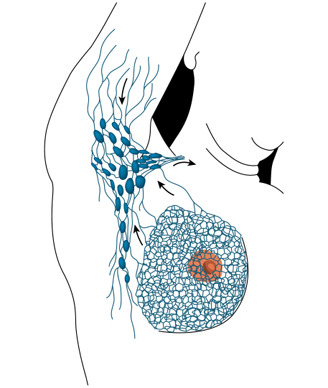Too Many DCIS Patients Get Axillary Lymph Node Dissection
No benefit of axillary lymph node evaluation has been shown for women with DCIS, yet this lymph node analysis is still often performed in these patients.
Image © Blamb / Shutterstock.com

While recommended for women with certain types of invasive breast cancer, axillary lymph node evaluation is not recommended for women with ductal carcinoma in situ (DCIS)-so-called stage 0 breast cancer-as no benefit has been found in these patients. However, this lymph node analysis is often unnecessarily performed in DCIS patients, according to a study published in JAMA Oncology.
Ellie J. Coromilas, BA, of the department of medicine at Columbia University, New York, New York, and colleagues found that nearly one-fifth of women with DCIS who undergo breast-conserving surgery are likely to have some sort of lymph node biopsy.
“Given the additional morbidity and cost of these procedures, alternative surgical approaches or prospective evaluation of the clinical benefit of axillary evaluation in women with DCIS is needed,” wrote the authors.
Even women with invasive breast cancer now can receive a sentinel lymph node biopsy (SLNB) rather than axillary lymph node dissection (ALND). Both the American Society of Clinical Oncology (ASCO) guidelines and those from the National Comprehensive Cancer Network (NCCN) recommend against ALND in women with invasive disease who undergo breast-conserving surgery. SLNB is associated with fewer comorbidities, such as lymphedema.
Coromilas and colleagues analyzed medical records from 2006 through 2012 of 35,591 women diagnosed with DCIS who had breast-conserving surgery or mastectomy. This captures approximately 15% of all patients in the United States diagnosed with DCIS during this 7-year period.
Rates of axillary evaluation in patients who had a mastectomy increased from 56.6% in 2006 to 67.4% in 2012. The rate remained roughly stable among patients who received breast-conserving surgery, from 18.5% in 2006 to 16.2% in 2012.
The majority of women with DCIS, 74.7% (26,580), had breast-conserving surgery; 25.3% (9,011) underwent mastectomy.
Among patients who underwent breast-conserving surgery, 17.7% had an axillary evaluation (SLNB, 16.7%; ALND, 1%). Among patients who underwent mastectomy, 63% had an axillary evaluation (SLNB, 47.8%; ALND, 15.2%).
In patients who underwent mastectomy, surgery at a non-teaching hospital and in an urban location were factors associated with an axillary dissection. Surgeon volume was the most significant factor for predicting axillary dissection among women who had breast-conserving surgery, according to the study results.
“A much larger proportion of women who had mastectomy underwent nodal evaluation compared with those undergoing breast-conserving surgery,” wrote Kimberly J. Van Zee, MD, MS, of the Memorial Sloan Kettering Cancer Center, New York, New York, in a commentary that accompanied the study. “This is reassuring, although the proportions undergoing nodal evaluation are not consistent with current guidelines.” Both the ASCO and NCCN guidelines recommend SLNB for women who undergo mastectomy to allow for staging of the axillary lymph nodes, since mapping of the breast is not possible after it has been removed.
“The management of breast cancer has undergone a radical transformation over the past few decades, and its evolution is continuing,” Zee concluded. “Coromilas and colleagues have shed some light on how the changes in recommended practice have been adopted in a broad sample of hundreds of predominantly small, urban, nonteaching hospitals across the country and by general surgeons who infrequently treat women with DCIS.”
Newsletter
Stay up to date on recent advances in the multidisciplinary approach to cancer.